| |
|
 | |
| MaltaWildPlants.com by Stephen Mifsud |

|
| |
|
|
 |  |  |  |
| External Links: |
|
Anacamptis collina (Fan-Lipped Orchid) |
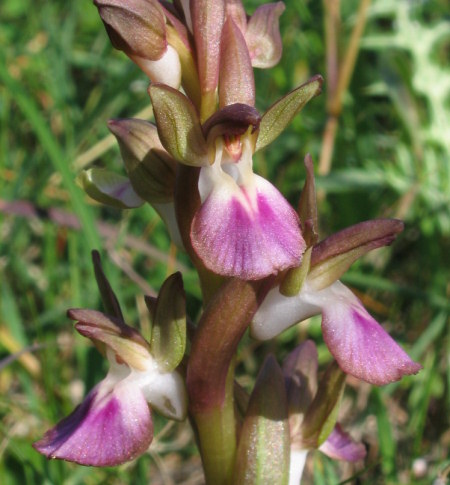
Anacamptis collina (ORCHIDACEAE.)
Images for this profile are taken from the Maltese Islands after year 2000. |
|
| Nomenclature |
Species name : | Anacamptis collina (Banks & Sol.) R.M.Bateman, Pridgeon & M.W.Chase | Authority : | Richard Mark Bateman, UK, (1958 - ) ;
Alec M. Pridgeon, UK, (1955 - );
Mark Wayne Chase, UK, (1951 - xxxx) | Synonyms :
(basionym or principal syn.) |
|
Plant Family : | | English name(s) : | Fan-Lipped Orchid, Red Orchid | Maltese name(s) : | Orkida ħamra | Status for Malta : | Indigenous. Present on the Maltese islands before man | Name Derivation : |
Anacamptis: "From the Greek ""anakamptein"" which means to curve or bend behind or backwards, referring to the backwards bent bracts located at the base of the labellum". (Greek origin ); 2 = testicle - referring to the pair of tubers which resembles testicles (Greek);.
collina: pertaining or related to a hill, most likely referring to the habitat of this plant, where in fact is most common on rocky slopes of hills. (Latin origin ); 2 = of or pertaining to a hill. Probably was found in large numbers for the first time on a hill. (Latin).
| Remarks : | |
|
| Morphology and structure |
PLANT STRUCTURE: |
Character | Growth Form | Branching | Surface |
Description | | | |
General
Picture |  | 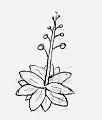 | 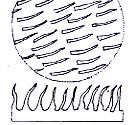 |
|
LEAVES: |
Character | Arrangement | Attachment | Venation |
Description | | | |
General
Picture | 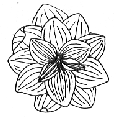 | 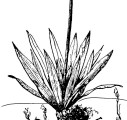 |  |
| |
Character | Leaf Shape | Leaf Margin | Remarks |
Description | | | |
General
Picture |  |  |  |
|
FLOWERS: |
Character | Colour | Basic Flower Type | No. of Petals | No. of Sepals |
Description | Purple, White and Green. Lip petal is purple, sepals are olive green. Mouth and spur are white. | | 3 2 small and inconspicuous and 1 complex and colourful (=labellum). | 3 2 lateral sepals are erect and spread-out while the central one is hood-like and subtending over the flower's staminode column. |
General
Picture | |  |  |  |
| |
Character | Inflorescence | Description | Ovary | Stamens |
Description | | The complex flower is made of 3 outer perianth segments (=sepals) and 3 inner perianth segments (= petals) of which the lower one - the lip - is larger, colourful and highly modified. The lip is unlobed, nearly spherical, bright purple to rose colour with a central pair of small and darker patches. The complex staminode column is purple-brown. At the back of the lip there is a white, sac-like spur. | | |
General
Picture |  |  |  | 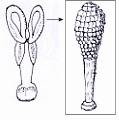 |
| |
Character | Scent | Average Flower Size | Pollen Colour | Other Notes |
Description | YES Flowers have a faint sweet smell that can be missed in wind. | 17mm x 10mm x 13mm (Length x Breadth x Depth). The Labellum is 10mm x 9mm (L X B). Sizes vary by few mm in flowers of different specimens. | Dull Green | - |
|
SEEDS: |
Character | No. Per Fruit | Shape | Size | Colour |
Description | > 2,000 Despite the large amounts, propagation by seeds is not much viable for Orchids . | Powder form (very small to have a distinct shape ). | Extremely small (powder form). | Ash Gray |
General
Picture |  |  |  |  |
|
FRUIT AND OTHER BOTANICAL DATA: |
Character | Fruit Type | Colour of Fruit | Subterranean Parts | Other Notes |
Description | | Green to Maroon | | Germination and Growth The germination and growth of the plant is successful only with the presence of specific microrhizzial funghi in the soil. |
General
Picture |  |  | 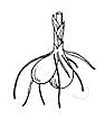 |  |
|
|
| Plant description and characters | |
Life Cycle: | Perennial. |
Growth Form: | GEOPHYTE (bearing underground bulbs, rhizomes, stolons, etc.) |
Habitat: | Calcareous garigue and steppes. Likes damp shallow soil but can tolerate arid environments. |
Frequency: | Frequent |
Localities in Malta: | Found as single specimens or isolated clumps, rather than in dense populations, but widespread through its native habitat in Malta and much less so in Gozo. |
Plant Height: | 6-22cm. |
| Feb-Mar |
Protection in Malta: | Not legally protected till the last update of this website (2/Mar/2022) |
Red List 1989: | Not listed in the Red Data Book of the Maltese Islands |
Poison: | |
This Orchid is one of the first orchids to blossom in Malta, usually by the end of January. The underground tubers initially forms a basal rosette of few leaves lying upon, or just above ground level. When the flowering stalk starts growing, the new leaves will instead grow higher up and wrap around the flowering stalk, probably for protection of the fragile buds. The flowering stalk is glabrous and its height varies between 6-30cm.
The leaves are broad oval to lorate (strap-like) in shape with a rather pointed tip. Some leaves have black dots. The outline is entire and parallel veins can be seen. If the leaves are simple, not the same can be said for the flowers. They are born in lax (loose) spikes, hence they are directly connected to the stalk by means of the ovary without any stalklet. There is a hood-shaped, maroon bract, about 2cm long, which covers most of the ovary and part of the back of the flower.
The flower consists of 3 outer perianth segments; sometimes referred to as sepals and 3 inner ones; sometimes referred to as petals. The sepals are arranged as an invert T-shape where the lateral ones are erect and have a sigmoid-oval shape resembling donkey ears. Their back is maroon while the front side is olive-green and have 2-4, longitudinal, dark green veins. The central sepal have a shape of a helmet and is located over the staminal column of the flower.
The petals are arranged as a Y-shape where the upper 2 petals are small and quite inconspicuous. These are close to each other and form a hood directly over the staminode column. In contrast the lower petal is large, colourful and modified - referred to as the lip or labellum. Unlike many Maltese orchids, the labellum is practically unlobed, and so it is sub-spherical in shape.
The labellum is bright purple, but some species have it more dull or pale (rose colour). There is a pair of darker or more intensely coloured patches at the centre separated by a white band. From these central patches there are radial brown veins which meet the margin of the labellum. The crenated margin is bronze-brown like the underside of the whole labellum. The rhombus-shaped mouth is white and at its back there is a sack-like spur also white or lilac.
At the opening of the mouth there are the reproductive organs of the flower. At the floor there is a cavity which leads to the spur. At the roof there is the staminode column. There are 2 purple-brown pouches (called theca) in which the pollinia reside. The pollina are dull green in colour and have a yellow caudicle and a hyaline, sticky viscidium. The stigma are located very near the staminode column and are tiny and difficult to spot.
The flowers develop into the fruit, which are elongated, oval capsules that produce numerous tiny seeds. These escape when the ripe fruit splits open. The fruit capsule is covered by the persistent bract. The plant develops asexually from division of tubers, or sexually from seeds, the former being a much more successful method.
|
|
| Information, uses and other details |
Nativity and distribution
According to reference [WWW-141] O. collina is found in Spain, France, Italy, Greece, the Greek islands, Turkey, Cyprus, Syria and Lebanon as a miniature to medium sized, cold to cool growing terrestrial orchid. Another reference [WWW-155] lists Albania, Spain, France, Greece Italy, Malte, Turkey as the main countries where this plant is found. In France, there are 22 Orchis species, of which Orchis collina is protected, together with O. coriophora fragrans, O. longicornu, O. pauciflora and O. spitzelli. [WWW-154]
In an interview with the French Dr. Jean Koenig, Vice Prèsident of the "Sociète Francaise d'Orchidophilie" and Prèsident of the Auvergne Orchid Society, he revealed that "apparently only one Orchid species disappeared in the France within the last 20 years and this is Orchis collina. He also said that this was originally an endemic from South France and became distributed to foreign countries where now it is a native plant. [WWW-153] See the links section below to read full interview.
General protection of wild Orchids
It is a well known fact that the Wild Orchids are in danger of disappearing from the wild. It is hence very important not to cut these flowers despite their curious beauty. Every plant makes just one single flowering stem, and cutting will simply mean destroying the whole flowering cycle as it will not form another flower stem during that year. Large efforts and dedicated time were involved to to include here large, excellent quality and high resolution photos of this plant (using special and expensive photographic accessories) for the purpose so that people at home can admire the beauty of this plant from these photos [SM]
In this profile's photo gallery you find 2 very large photos for printing purposes. You can print it up to a poster size and admire it without the need of cuting the flowers! Alternatively, just take the challenge and fun of it - take your own good photos of this plant without cutting. [SM]
Personal Observations
Variation of the flower
There is a certain degree of variation between flowers of different species of Orchis collina. These are abriefed in the list below: [SM]
1) General colour of labellum
Ranges from bright purple (magenta) to paler colours (rose or pink)
2) Shape of labellum
In some species it is flat (sacucer shaped) while in others its edges are found slightly curved down.
3) Shape of labellum outline
Some species have a more crenated labellar outline than others, and in some cases a small notch is found at the tip of the labellum.
4) Colour of labellum outline
The outline or border of the labellum is bronze-brown. The thickness varies where in some is confined to the rim, while others can have 2mm border.
5) Radiating veins of the labellum
Many species have labia with prominent brown veins radiating out to the margin, but in some species these are less distinct.
6) Central patches
The labellum is further decorated by 2 rather triangular or V-shaped patches at the centre, separated by a white band. The intensity and prominency of these patches varies, but usually it corresponds with how much colourful the general labellum is. [SM]
Plant Height
The plant is generally described to be between 12-30cm heigh. Interetingly, several species in Malta where found to be smaller, about 8cm where the smallest flowering species was just 6cm long. [SM]
O. collina among the first flowering Orchids of Malta
This Orchid is one of the first flowering orchids in Malta. It is normally in flower by the end of January, depending on seasonal weather conditions. Other common early flowering Orchids are Ophrys mesaritica (which flowes in the beginning of January) and Orchis conica which flowers at the same time with O. collina. [SM]
Identification marks
This orchid is easily distinguishable from other wild ones by the following specific morphological features [SM]:
1) The labellum is not lobed, but has an entire crenated margin. Note however that some species of O. collina have a very small indentation at the tip of the labellum.
2) It is one of the few species in the Orchis genus to have its 2 lateral outer perianth segments erect and spread-out (referred to as patent). Many Orchis species have them bent down as a hoodt over the staminode column. The shape of these erect tepals resemble that of donkey ears.
Not much information about this plant has been found, neither in books nor on the Internet. If you can supply further information to be included in this profile, please, do not hesitate to email me. Full reference credits will be given.
|
|
| Links & Further literature
(0 papers) |

Google Web |

Google Images |

Google Scholar |

Research Gate |

Wikipedia |

JSTOR |

GBIF |

Med Checklist |

Cat. of Life |

EoL |

IPNI |

World Flora Online |

Plants of the World Online |

Vienna Virt. Herb. |

RBGE Herbarium |

KEW Herbarium |

MNHN |

Arkive |

IUCN |

CABI |
Kindly Email if there are papers and publications about local
studies or information about this species to be included in the list above.
|
| Photo Gallery (52 Images) |  |
 |
 |
 |
IMAGE: ANCCL-01 Photo of the typical flowers of this orchid that blossoms by the end of January till end of February. |
IMAGE: ANCCL-02 Photo of the flowering spike, described as lax since its flowers are not crowded. Up to 15 flowers per inflorescence can be found. |
IMAGE: ANCCL-03 Photo of flowers which vary from the previous examples by having a labellum with a less bright purple colour (sometimes described as a rose colour). |
IMAGE: ANCCL-04 Photo of flowers of a plant found in the shade of the wall of the Victoria lines at Wied Anglu, limits of Gharghur, Malta. (2- Feb-06). |
 |
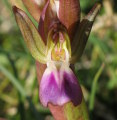 |
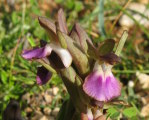 |
 |
IMAGE: ANCCL-05 Close up photo of 2 flowers. 2 of the outer perianth segments are erect and spreading out. This is an important identification feature since most Orchis species have them curved in as a helmet over the staminode column. |
IMAGE: ANCCL-06 Close up photo of flower (front view). The flower mouth is white and at its roof there are 2 maroon structures, each known as a theca, that covers completely the pollinia (male organs) inside. |
IMAGE: ANCCL-07 Close up photo of 2 flowers orientated at right angles to each other. The lateral view of the flower shows well the white, sack-like spur which measures about 16mm long (tip to the labellum) and 6-7mm wide. |
IMAGE: ANCCL-08 Close up photo of the flower. Note the slightly crenated or lacerated margin of the labellum. The veins and central bright patches on the labellum are not prominent in this species. |
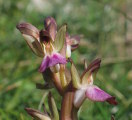 |
 |
 |
 |
IMAGE: ANCCL-09 Photo of two flowers of a plant found at Mistra (near Rxawn cliffs). The erect, olive-green sepals have a shape resembling donkey ears and possess 1-4 longitudinal dark green veins. |
IMAGE: ANCCL-10 Another close up photo of the flowers. This species have the labellum curved down rather than flat. There is a small degree of variation between flowers of different species of O. collina.. |
IMAGE: ANCCL-11 Photo of the flowering spike showing 2 lateral views of the flowers. Flowers are located at a slightly different level of which the lower one is the first to blossom and hence the oldest of them all. |
IMAGE: ANCCL-12 Photo showing the underside of the flower. The labellum is maroon or bronze-brown in colour. It joins the curved-down spur which has a white or lilac colour. |
 |
 |
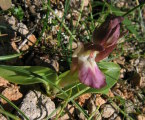 |
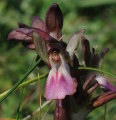 |
IMAGE: ANCCL-13 Close up photo of the flower showing the detail of the staminode column at the opening of the flower mouth. |
IMAGE: ANCCL-14 Photo of same flower at a different angle showing detail of the labellum and its erect sepals. |
IMAGE: ANCCL-15 Photo of flower which is rather pale and the central patches are not so bright or prominent. |
IMAGE: ANCCL-16 Photo of another flower which has a rather pale labellum. |
 |
 |
 |
 |
IMAGE: ANCCL-17 Photo of a flower which have a bright purple colour and a brown outline. |
IMAGE: ANCCL-18 Photo of a flower which has a purple colour that is very bright and well visible brown veins at the border. The central deep purple patches are also quite prominent. |
IMAGE: ANCCL-19 Macro photo of staminode column above the mouth of the flower. There are 2 pollinia, each in a pouch-like covering called theca. The median sepal and the 2 upper petals hood over the staminode column. |
IMAGE: ANCCL-20 Macro photo of the mouth of the flower. Inside there is an entire pollinium carried from another flower by the pollinating insect. From this location it comes in contact with the stigma and so it fertilizes the flower. |
 |
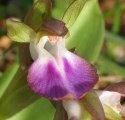 |
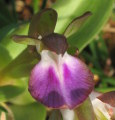 |
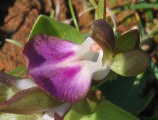 |
IMAGE: ANCCL-21 Photo of the beautiful and highly coloured labellum of this species. This example have a bright purple colour and radiating brown veins reaching the margin. |
IMAGE: ANCCL-22 Photo of the same labellum in the previous photo at a different angle. This species have a small notch at the tip. |
IMAGE: ANCCL-23 Photo of same labellum in the previous photo at a different angle. In this species the labellum is circular and rather flat like a saucer. In other species it is found curved down. |
IMAGE: ANCCL-24 Photo of the same labellum in the previous photo at a different angle. The two, central patches have an intense purple colour and are separated by a longitudinal white band originating from the mouth. In other species it is less conspicuous. |
 |
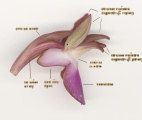 |
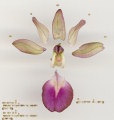 |
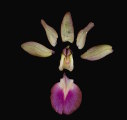 |
IMAGE: ANCCL-25 Scanned image of the flower with its sepals and upper petals forced spread out. This flower have a relatively thick brown margin. |
IMAGE: ANCCL-26 Annotated scanned image of the lateral view of the flower. |
IMAGE: ANCCL-27 Scanned image of a flower with petals and sepals dissected out and marked accordingly. |
IMAGE: ANCCL-28 Scanned image of a flower with petals and sepals dissected out against a dark background. |
 |
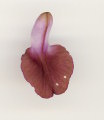 |
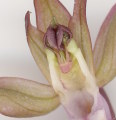 |
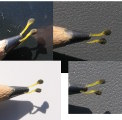 |
IMAGE: ANCCL-29 Scanned image of a young flower. Note the green pollinium inside one of the maroon pouches. |
IMAGE: ANCCL-30 Scanned image of the underside part of the labellum and the spur. |
IMAGE: ANCCL-31 Scanned image of the staminode column. There are 2 pouch-like structures (each called theca) which inside hold the pollinia. These have a green colour and resemble the shape of a corn on the cob. |
IMAGE: ANCCL-32 4 photos of the pair of pollinia present in each flower. These pollinia are the same in each photo and belong to the same flower. They are photographed against a different background. They have an interesting dull green colour with a yellow caudicle and hyaline viscidium. |
 |
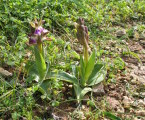 |
 |
 |
IMAGE: ANCCL-33 Photo of a small plant. Interestingly, O. collina is described to be a plant that has a height of 10-30cm, but in Malta it is common to find shorter species like this that measures about 6-8cm. |
IMAGE: ANCCL-34 Photo of two plant in close vicinity. Usually, O. collina is found independently. |
IMAGE: ANCCL-35 Photo of a plant that bears pale purple (pink) flowers. Mistra garigue/4-Feb-2006). |
IMAGE: ANCCL-36 Photo of a plant that bears paler flowers. |
 |
 |
 |
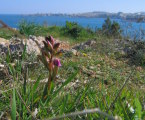 |
IMAGE: ANCCL-37 Photo of a plant which bears deep purple flowers. |
IMAGE: ANCCL-38 Photo of a plant found at Mistra, beside the Xemxija Civil Protection Department. |
IMAGE: ANCCL-39 Photo of a young plant and its first flower. |
IMAGE: ANCCL-40 Photo of a plant with St. Paul's Bay at the background. |
 |
 |
 |
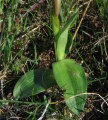 |
IMAGE: ANCCL-41 Photo of a plant in its natural habitat - a garigue. |
IMAGE: ANCCL-42 Photo of a plant with pale flowers, no labellar veins and non-showy central patches on the labellum. |
IMAGE: ANCCL-43 Scanned image of the plant. Note that in this photo-gallery, all scanned images where obtained from the same 'sacrificed' plant. |
IMAGE: ANCCL-44 Photo of the simple leaves. The lower ones are arranged as a basal rosette, while the upper 2 or 3 leaves become erect and partially wrapping the delicate flowering stalk. |
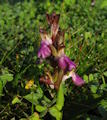 |
 |
 |
 |
IMAGE: ANCCL-45 Photo of plant having bright purple flowers with dew. |
IMAGE: ANCCL-46 Photo of a typical Orchis collina (=O. saccata) in the Maltese Islands, flowering in February. |
IMAGE: ANCCL-47 Side view photo of a specimen showing the short and broad spur. |
IMAGE: ANCCL-48 Photo of a specimen of Orchis collinawith pale colour with shades of pale brown. This colour form is encountered ocassionally (infrequent) and one can get confused of being another species. |
 |
 |
 |
 |
IMAGE: ANCCL-49 Another photo of the pale form of O. collina. |
IMAGE: ANCCL-50 Closeup photo of ventral view of a flower of the Red Fan Orchid. |
IMAGE: ANCCL-51 Closeup photo of lateral view of a flower of the Red Fan Orchid. |
IMAGE: ANCCL-52 Photo of plant showing its flowering spike and leaves. These Orchids are often found individually, or if in small groups, the specimens are always spaced out well between each other. |
|
| | |